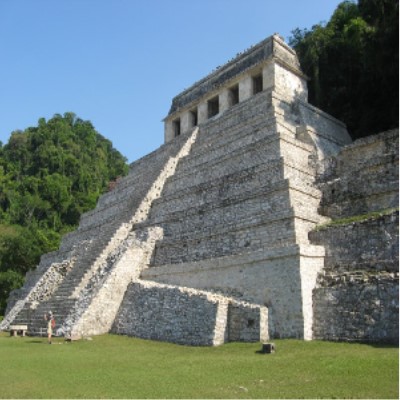Mesoamerican Photo Archives
This website, created by David R. Hixson, a graduate student in anthropology at Tulane University, provides 100 photographs and information about 11 archaeological sites in Mexico. Sites include Bonampak in the Mexican state of Chiapas; Calakmul in southern Mexico near Guatemala; Cacaxtla, Teotihuacan, Chalcatzingo, Xochicalco, and Cholula in central Mexico; Monte Alban in Oaxaca; and Ek Balam in Yucatan. There are also images of Chultuns, ancient Maya chambers in Yucatan, and the Loltun Caves in Yucatan. The site also offers 28 links to the National Museum of Anthropology in Mexico City and other sites with information on Mesoamerican civilizations.
The information on the archaeological sites is inconsistent and might be frustrating for non-archaeologists, although the website is expanding. For example, the section on Cacaxtla does not include information about its location or the people who lived there, and there is almost no background information on Ek Balam. There are also references to specific periods (such as the classic period of Maya civilization) without explanation or dates offered. Many of the sites, however, are described more fully, with information about the geographical location, the people who built the site, and when and how they lived. Hixson overcomes the lack of information about some of the archaeological sites by providing extensive links to websites with more information. In addition, a quick search on the Web using the name of specific archaeological sites will help locate basic information.
The strongest feature of this site lies in the detailed information that Hixson provides about the uses of the buildings and the overall layouts of the sites. He has photographs of specific buildings, architectural details, and murals, and he describes how these buildings and other objects might have been used and the significance they may have held in the lives of the people who created them. The photos, ranging from three to 20 per archaeological site, are high quality, clear, and well-composed. Photographs were taken between 1997 and 2001. Another strength is that the examples are taken from different periods, such as the Loltun Caves, which were used during the Ice Age, and Cholula and Xochicalco which emerged after Teotihuacan fell in about the 7th century CE. There are links to information on later civilizations such as the Aztec, and the Museum of Anthropology in Mexico is developing online material about later civilizations such as Tula and the Aztec empire.
Teachers might ask students what they can figure out about the people who built and used these sites by looking first only at the images of the sites. What kind of technology did the inhabitants of Cholula need to build their huge pyramid? What might the pyramids of Teotihuacan and Cholula have been used for, given their positions in the overall site plans and their size and design? What kind of labor was needed to build these sites and where might that labor have come from? What does the layout of certain sites suggest about the cosmological beliefs of the people who designed them? Then students could test their theories by consulting the website or by doing other research. For example the Teotihuacan website would supplement the information provided here, as would the other links Hixson provides. Students might also compare these Mesoamerican civilizations to contemporary ones in Europe, Africa, and Asia. What was happening in the “Old World” when the Maya of Bonampak were engaging in warfare and painting murals? The excellent images provided here can serve as a stimulus to further research for students interested in Mesoamerican history and in broader comparative history.
